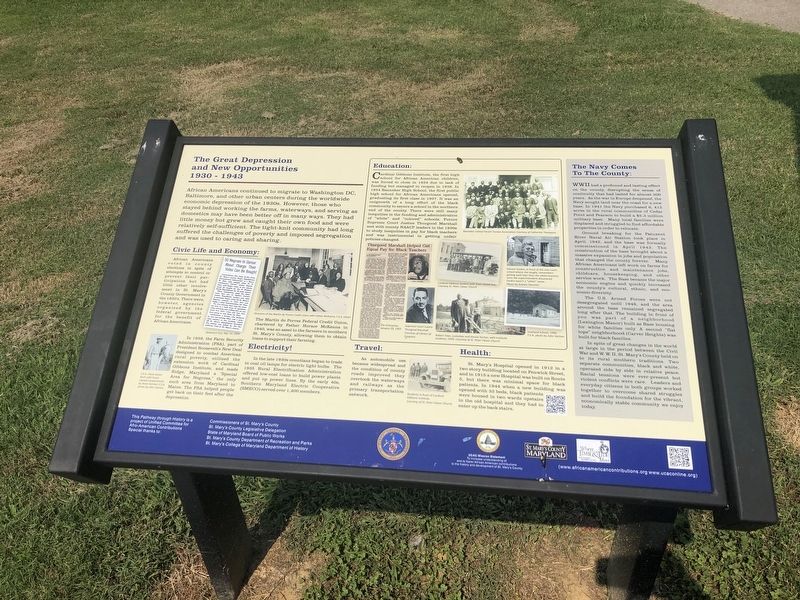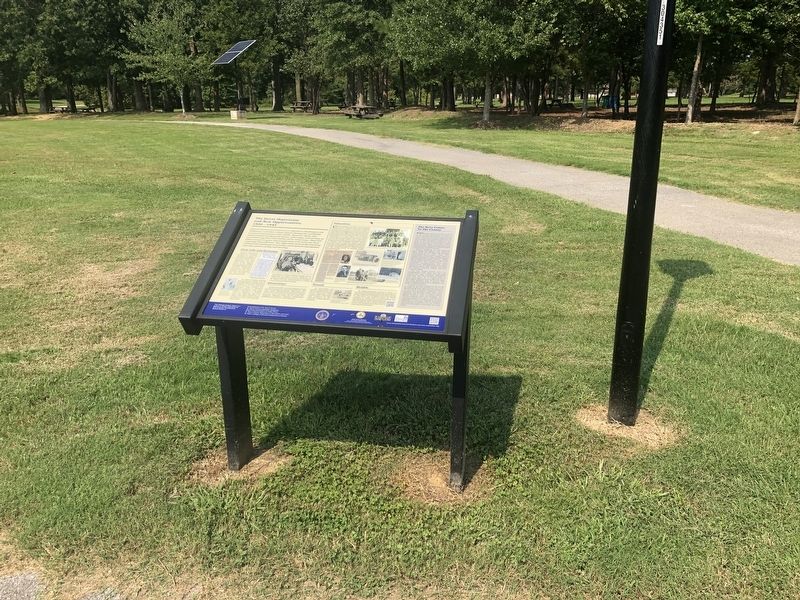Lexington Park in St. Mary's County, Maryland — The American Northeast (Mid-Atlantic)
The Great Depression and New Opportunities
1930 - 1943

Photographed By Devry Becker Jones (CC0), September 12, 2021
1. The Great Depression and New Opportunities Marker
African Americans continued to migrate to Washington DC, Baltimore, and other urban centers during the worldwide economic depression of the 1930s. However, those who stayed behind working the farms, waterways, and serving as domestics may have been better off in many ways. They had little money but grew and caught their own food and were relatively self-sufficient. The tight-knit community had long suffered the challenges of poverty and imposed segregation and was used to caring and sharing.
Civic Life and Economy:
African Americans voted in county elections in spite of attempts to control or prevent their participation but had little other involvement in St. Mary's County Government in the 1930's. There were, however, agencies organized by the federal government for the benefit of African Americans.
In 1939, the Farm Security Administration (FSA), part of President Roosevelt's New Deal designed to combat American rural poverty, utilized the extension work of Cardinal Gibbons Institute, and made Ridge, Maryland a "Special Area for Negroes," the only such area from Maryland to Maine. The FSA helped people get back on their feet after the depression.
The Martin de Porres Federal Credit Union, chartered by Father Horace McKenna in 1940, was an asset to the farmers in southern St. Mary's County, allowing them to obtain loans to support their farming.
Electricity!
In the late 1930s countians began to trade in coal oil lamps for electric light bulbs. The 1935 Rural Electrification Administration offered low-cost loans to build power plants and put up power lines. By the early 40s, Southern Maryland Electric Cooperative (SMECO) served over 1,400 members.
Education:
Cardinal Gibbons Institute, the first high school for African American children, was forced to close in 1934 due to lack of funding but managed to reopen in 1938. In 1934 Banneker High School, the first public high school for African Americans opened, graduating its first class in 1937. It was an outgrowth of a long effort of the black community to secure a school in the northern end of the county. There were still many inequities in the funding and administration of "white" and "colored" schools. Future Supreme Court Justice Thurgood Marshall met with county NAACP leaders in the 1930s to study inequities in pay for black teachers and was instrumental in getting unfair policies changed.
Elavare Gaskin, in front of the one-room school where she taught, remembers getting paid later than white teachers once the superintendent discovered Gaskin wasn't a "white" name.
Travel:
As automobile

Photographed By Devry Becker Jones (CC0), September 12, 2021
2. The Great Depression and New Opportunities Marker
Health:
St. Mary's Hospital opened in 1912 in a two story building located on Fenwick Street, and in 1915 a new Hospital was built on Route 5, but there was minimal space for black patients. In 1944 when a new building was opened with 32 beds, black patients were housed in two wards upstairs in the old hospital and they had to enter up the black stairs.
The Navy Comes To The County:
WWII had a profound and lasting effect on the county, disrupting the sense of continuity that had lasted for almost 300 years. As the war in Europe deepened, the Navy sought land near the coast for a new base. In 1941 the Navy purchased 6,412 acres in the rural communities of Cedar Point and Pearson to build a $5.3 million military base. Many local families were displaced and struggled to find affordable properties in order to relocate.
Ground breaking for the Patuxent Rival Naval Air Station took place in April, 1942, and the base was formally commissioned in April 1943. The construction of the base brought about a massive expansion in jobs and population that changed the county forever. Many African Americans left work on farms for construction and maintenance jobs, childcare, housekeeping, and other service work. The Base became the major economic engine and quickly increased the county's cultural, ethnic, and economic diversity.
The U.S. Armed Forces were not desegregated until 1948, and the area around the base remained segregated long after that. The building in front of you was part of a neighborhood (Lexington Manor) built as Base housing for white families only. A second "flat tops" neighborhood (Carver Heights) was built for black families.
In spite of great changes in the world at large in the period between the Civil War and W.W.II, St. Mary's County held on to its rural southern traditions. Two, separate communities, black and white, operated side by side in relative peace. Racial tensions were ever-present but violent conflicts were rare. Leaders and everyday citizens in both groups worked together to overcome shared struggles and build the foundation for the vibrant, economically stable community we enjoy today.
Erected by Unified Committee for Afro-American Contributions Special thanks to: Commissioners of St. Mary's County; St. Mary's County Legislative Delegation; State of Maryland Board of Public Works; St. Mary's County Department of Recreation and Parks; St. Mary's College of Maryland Department of History.
Topics and series. This historical marker is listed in these topic lists: African Americans • Civil Rights • Education • Forts and Castles. In addition, it is included in the Rural Electrification 💡 series list. A significant historical month for this entry is April 1942.
Location. 38° 15.67′ N, 76° 26.921′ W. Marker is in Lexington Park, Maryland, in St. Mary's County. Marker is on Rennell Avenue West, 0.2 miles east of Willows Road, on the left when traveling east. Touch for map. Marker is at or near this postal address: 21550 Willows Rd, Lexington Park MD 20653, United States of America. Touch for directions.
Other nearby markers. At least 8 other markers are within walking distance of this marker. Two Worlds / One County (a few steps from this marker); A "War to end all Wars" (within shouting distance of this marker); Defining Freedom and Building Community (within shouting distance of this marker); Lexington Park (within shouting distance of this marker); Navy Base Arrives (within shouting distance of this marker); St. Mary’s County and U.S. Navy History (within shouting distance of this marker); Architectural Significance of the First Lexington Park Community (within shouting distance of this marker); United States Colored Troops (within shouting distance of this marker). Touch for a list and map of all markers in Lexington Park.
Credits. This page was last revised on September 13, 2021. It was originally submitted on September 13, 2021, by Devry Becker Jones of Washington, District of Columbia. This page has been viewed 157 times since then and 12 times this year. Photos: 1, 2. submitted on September 13, 2021, by Devry Becker Jones of Washington, District of Columbia.